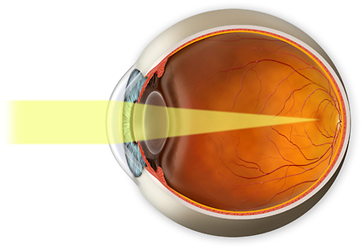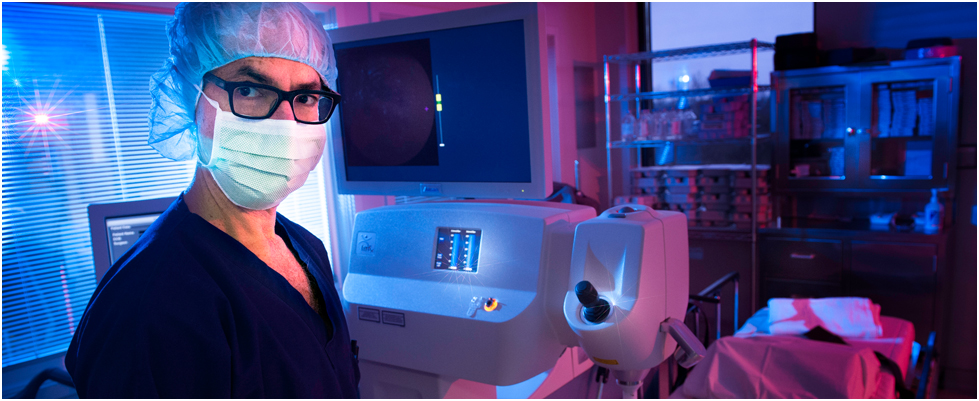About Cataracts
As we get older, cataracts become a problem experienced by a great number of people just like you. Cataracts are a common cause of vision problems among people in their 50’s and 60’s and they are actually a major cause of senior eye problems and vision loss. More than 20 million Americans age 40 and older have cataracts and more than half of all Americans develop cataracts by age 80. A cataract is a clouding of the crystalline lens of the eye preventing light rays from passing through it easily. This results in a clouding and blurring of vision. For many patients, cataracts start out slowly and have little effect on vision at first. But, as the cataract becomes denser, so does the impact on vision.
Risk Factors for Cataracts
Since cataracts develop as part of the aging process everyone is eventually at risk for developing cataracts. However there are certain known factors that increase your risk of developing cataracts. Advancing age is a cataract risk factor such that by age 75, 70% of seniors have cataracts. Any family history of cataracts or having diabetes, obesity or high blood pressure increases your risk of cataracts. Smoking is a well known risk factor for many eye problems-including cataracts. Anyone exposed to excessive amounts of UV light from the sun or really any source increases their cataract risk as does any previous eye surgery, injury or inflammation or use of certain medications such as steroids for asthma or Chronic Obstructive Pulmonary Disease (COPD).
Symptoms of Cataracts
The most common symptoms of cataracts that bother patients include blurry or cloudy vision, sensitivity to light and glare, double vision in one eye, poor night vision including starbursts and haloes around lights, fading or yellowing of colors, and often a need for frequent changes in glasses or contact lens prescriptions.
Development of Cataracts
In order for you to have clear vision, light must be able to pass through the optical structures of your eyes and focus properly on the retina.

The two primary structures that are responsible for refracting, or bending light so that it can focus properly on the back of the eye, are the cornea, which is the outermost clear curved “lens” that is visible when looking at your eye from the side, and the crystalline lens, which is located behind the colored part of the eye, or the iris, and is not directly visible. The crystalline lens will be examined during your eye exam by using specialized instruments to look through the pupil, or the dark center of the iris. Both the cornea and the crystalline lens need to be perfectly clear in order for you to have good vision. If you are in good health and have not had chronic eye infections, inflammation or had any trauma to your eyes, the cornea is likely to maintain its clarity throughout your life. The crystalline lens however, undergoes a number of changes that progress as we age. These aging changes can affect your vision.
Even if you have had “good eyes” and “normal vision” all your life, your vision is likely to begin to change in a number of ways as we progress from our 40’s, to our 50’s and then our 60’s and beyond. The most obvious changes to our vision occur as a result of these changes in the crystalline lens.
The two most common changes that occur in the crystalline lens are:
- A loss of flexibility, called presbyopia, which makes it harder to read and
- A loss of optical clarity, which can be caused by a cataract.
When we are younger, the crystalline lens is usually soft, flexible and “crystal” clear so that it has excellent transparency and optical clarity. As we progress through our 50’s and 60’s, the normally “crystal” clear lens may gradually become yellow and cloudy. When this occurs, you may initially experience a mild blurring of your vision and feel that you might need a change of eyeglasses. As the crystalline lens loses its transparency and its optical clarity, you may notice that it is not as easy to see well and comfortably in dim illumination, such as for night driving. You may notice that colors look faded. The cloudiness may also create glare, haloes, light sensitivity, and a continuing decrease in your vision. If the crystalline lens becomes too cloudy, it may cause a significant decrease in both your day and night vision. These are the visual symptoms that are common for those patients whose crystalline lens has clouded and formed a cataract.
About Presbyopia & Near Vision
Presbyopia is an aging phenomenon that begins at around age 40 and progresses until about age 65 as the crystalline lens loses its flexibility. This flexibility allows the crystalline lens to change its shape and alter its curvature in order to rapidly focus your vision at various distances, from far to near, to arm’s length, to far or near again. The focusing capacity of the crystalline lens gives you the ability to see things at all distances. Around the time we enter our 40’s, the crystalline lens begins to stiffen. The stiffening of the crystalline lens makes it progressively more difficult to change focus from distance to near, thus making it more difficult to see close up. Initially, this reduces our ability to see objects clearly at arm’s length. As presbyopia progresses, it becomes more difficult to see reading material or objects close up.
As patients begin to experience presbyopia, they often notice that their "arms are too short" requiring them to see up close by moving near objects and reading material farther away in order to bring them into focus and to see them clearly. It is important to know that presbyopia affects everyone, including those who have cataracts. As Presbyopia begins, people who have never worn eyeglasses find that they need reading glasses or bifocals in order to read and see up close. People who already wear glasses may need bifocals or trifocals in order to see up close and have comfortable near vision.
Advances in cataract surgery and lens implants allow us to correct nearsightedness, farsightedness and astigmatism, as well as the near vision focusing problem, presbyopia, with advanced technology lens implants. Near vision presbyopia correcting lens implants allow us to correct distance, arm’s length and near vision to help patients achieve clear distance vision as well restore their normal range of vision without relying on eyeglasses, bifocals or reading glasses. At Baltimore Washington Eye Center we offer near vision correction lens implants such as the AcrySof® ReSTOR® Multifocal Lens Implant (IOL), as well as lens implants for astigmatism, such as the AcrySof® Toric Lens Implant.
Cataracts can affect us even if we have had normal vision all of our lives. It is important to note that cataracts are even more common if we have had certain health problems, such as diabetes, or taken certain medications such as cortisone for asthma or other types of inflammatory conditions. If you are experiencing vision changes like these, it is important to schedule a comprehensive eye exam and cataract evaluation at Baltimore Washington Eye Center.
Patients wishing to learn more about cataracts in the greater Baltimore or Washington, D.C area are encouraged to call us at 800-495-3937 to schedule an appointment.


